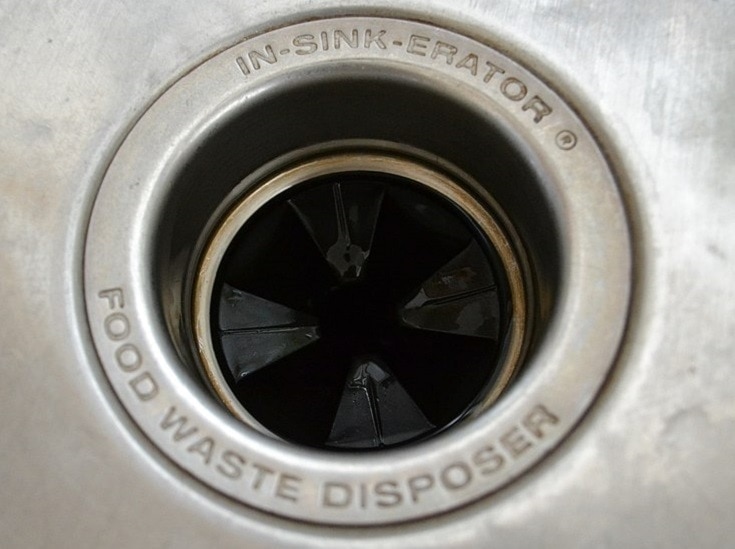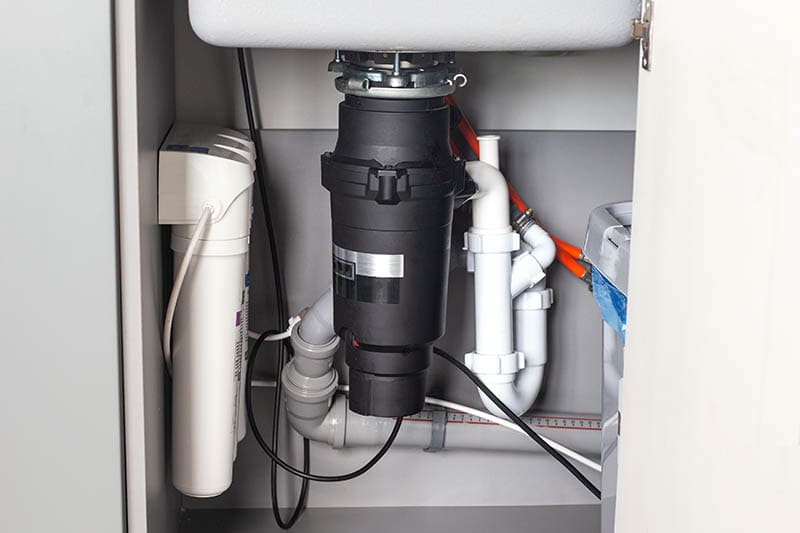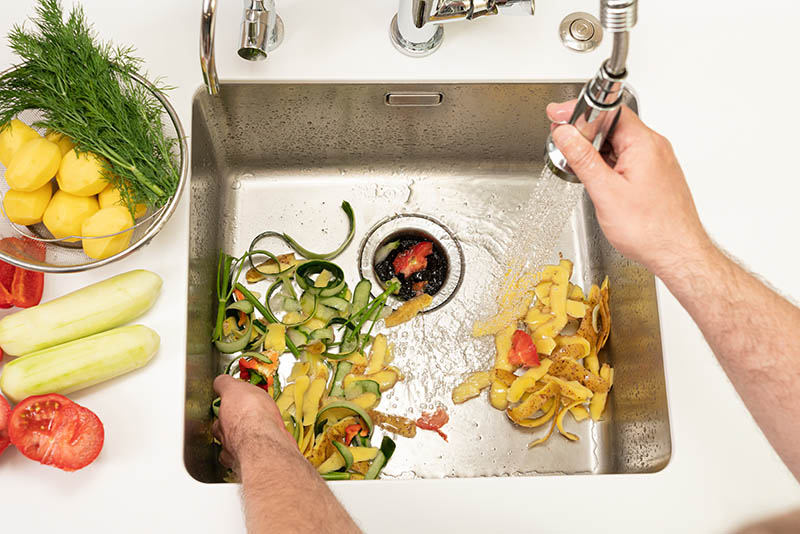How Does a Garbage Disposal Work? Everything You Need to Know!
-
Pete Ortiz
- Last updated:

Most kitchens in the US are equipped with a functional garbage disposal unit. It makes disposing of food waste faster and easier and prevents waste from accumulating. Garbage disposal units come in many sizes, so you should pick one depending on your personal needs, including the amount of food waste your household generates.
Most homeowners believe that garbage disposal works like a blender and are unaware of all the units’ components and their roles. If you are interested in learning how a garbage disposal works, how to use it correctly, and its pros and cons, read on.
How It Works
Garbage disposals are electric-powered and have a small motor that rotates a blade enabling it to chop up anything you put in the grinding chamber. In most cases, the drain from the dishwasher empties into the garbage disposal allowing the bits of food waste to be ground up before passing through the plumbing.

Follow the following steps to operate the garbage disposal correctly:
- Turn on the garbage disposal unit by flipping the switch next to the sink or above the counter.
- Run cold water through the garbage disposal before turning it on and pushing the food waste through to clean the blades and enable the ground-up waste to pass through without clogging the pipes.
- Feed the food waste into the garbage disposal gradually. Ensure the food waste is in small pieces to avoid overworking the unit. The food waste falls through the grinding chamber, equipped with a spinning flywheel with sharp grinding teeth that grind the food waste into smaller pieces.
- Turn off the garbage disposal unit and allow the cold water to run for a few seconds to flush the waste into the sewer line. The ground-up food waste is carried through the sewage system and taken to the treatment plant where it’s treated.
Tips for Using a Garbage Disposal Correctly
If you want your garbage disposal unit to last longer without breaking down, you need to use it safely and efficiently. The following tips can help ensure that you do it the right way:
- Put small amounts of food in the garbage disposal unit to avoid overloading and clogging. Hard and large items such as bones and shells can damage the unit. You should also avoid putting fibrous foods in the garbage disposal unit since the fibers tend to wrap around the blades, which causes them to jam.
- Clean and maintain the garbage disposal unit regularly to ensure it works efficiently. Cleaning may involve opening up the unit and cleaning the individual parts or using a special tool to remove the debris that may have accumulated to prevent clogs. Avoid using harsh chemicals since they can damage some parts of the unit.
- Don’t put your hand inside the garbage disposal even when it’s clogged. When the wedged food is removed, the blades can start whirling, which can cause significant injuries. Instead, try using tools to dislodge the debris or call a plumber to fix it.
- Run cold water while the garbage disposal is running. Doing so helps flush the ground waste in the sewage system and keep the unit clean.
Different Types of Garbage Disposal Systems

There are five types of garbage disposals in the market. The type of garbage disposal unit you choose will depend on your budget and specific needs. Some brands are better equipped than others, and you need to consider the size of your household, the amount of waste you generate, and the kind of plumbing system in your kitchen.
1. Batch Feed Garbage Disposals
Batch feed garbage disposals grind the food waste into small batches. They are activated by a special spotter that has to be placed inside the drain before the unit can operate and grind the food waste. After placing small amounts of food waste in the unit, put the stopper back over the opening and turn the switch on to avoid food waste from getting all over the place.
Batch feed units are among the safest since it’s difficult to overload accidentally. It’s also harder for children to put their hands or the wrong items in this unit because they come with a stopper/ cover. The downside, however, is that it may not be convenient for large amounts of food waste.
2. Standard Garbage Disposals
Standard garbage disposals are the most common in most households and establishments. They can be activated by turning on the switch and will grind food as long as the switch is not turned off. Unlike batch-feed garbage disposal units, standard garbage disposals can handle a large amount of food waste, making it easy to overload the unit.
These units are available in various sizes and power levels. However, they are not suitable for households with young children since they can stick their hands inside the garbage disposal at any point when it’s on.
3. High-Power Garbage Disposals
High-power garbage disposal units are bigger and use more horsepower than standard disposal units. They are ideal for use in restaurants that generate a lot of waste. One of the main reasons they are quite popular is because they contain additional features such as multiple motors and grinding plates that increase their grinding potential, thus increasing their efficiency.
4. Compact Garbage Disposals
Compact garbage disposal systems are smaller than other units and can be installed in the space below the sink. They are also less powerful and ideal for small households since they can only grind small amounts of food waste. Compact garbage disposal units are less expensive than other units.
Where Is a Garbage Disposal Used?

Garbage disposals are efficient and can be used in households, restaurants, and large establishments that generate a lot of food waste. The type of garbage disposal units used in industrial settings is larger and more powerful. Most have multiple spinning grinders to accommodate large amounts of food waste.
The type of garbage disposal units typically used in households is small and with less power. They can be fitted under the sink and are quite simple to operate. Additionally, they come with safety features, including a cover and a hard-to-access switch to prevent small children from injuring themselves.
The size and power of the garbage disposal you choose to get will be determined by where you want to use it and the amount of food waste produced. It will also depend on how often you’ll be using the disposal.
Advantages of a Garbage Disposal
A garbage disposal is a valuable appliance in the kitchen since it makes work easier and reduces the amount of food waste in the kitchen. Other advantages of having a garbage disposal in your kitchen include the following:
1. Odor Control
Once the food waste has been passed through the garbage disposal and ground into small pieces, it’s pushed through the sewer and taken to the treatment plant. This is a better solution for dealing with food waste instead of dumping it in the garbage and leaving it to rot, which creates a bad odor in the house.
2. Environmental Benefits
One of the key benefits of having a garbage disposal is that it reduces the amount of food waste dumped on the environment. It cuts down on the greenhouse gases emitted by garbage trucks that would otherwise be deployed to collect the food waste and the methane gas produced in landfills when the food waste rots. Additionally, waste treatment plants can use it as a source of biogas or fertilizer.
3. Reduces Pests
Pests such are rats, flies, and cockroaches are attracted to food waste in the garbage and can create unsanitary conditions. Disposing of the waste in the kitchen disposal reduces the likelihood of having pests in your kitchen since it grinds up the waste and flushes it through the sewage system.
4. Long Lifespan
Although there are different types of garbage disposals, most of them can last for a long time with minimal maintenance. Some can last for more than a decade, and fixing them is free for the first few years if they come with a warranty.
5. Convenience
Having a garbage disposal system in your home is convenient. It enables you to get rid of food waste easily and without much effort compared to other methods of waste disposal.
Disadvantages of a Garbage Disposal

While garbage disposals are environmentally friendly and more cost-efficient in the long run, they may only be ideal for some. It’s vital to weigh all the pros and cons before purchasing and installing a garbage disposal. Some of the disadvantages include the following:
1. Cost
One of the main challenges most people face when getting a garbage disposal is the costs involved. They can be expensive to purchase and install, especially if you need to change the plumbing to accommodate the unit.
2. Noise
Another disadvantage of using garbage disposals is the amount of noise they can produce; this is a greater challenge if you live in an apartment or have close neighbors. The best time to use the garbage disposal is during the evening, while morning and night are the worst time since sound carries more. However, it’s important to note that the amount of noise a garbage disposal produces depends on the size and power of the unit.
3. Water Usage
Garbage disposal requires a constant flow of water to flush down the ground-up food waste into the sewage system and avoid clogging. This can be challenging in areas with low water supply or high water bills. It’s also not the most environmentally friendly method due to the amount of water used.
4. Limited Capacity
Although garbage disposal is designed to handle a lot of food waste, it can break down or get clogged when used to grind hard or large items such as bones. They are better equipped to handle smaller and softer food waste.
5. Maintenance
Like most home appliances, garbage disposal requires frequent maintenance to ensure that they are operating correctly. Maintenance should be done by a professional and typically involves cleaning the unit and removing any debris clogging it.
Frequently Asked Questions (FAQs)

What is the proper way of cleaning a garbage disposal unit?
Cleaning a garbage disposal unit is quite easy. The best way to go about it is by using a solution of baking soda and vinegar—pour a cup of vinegar down the drain and let it sit for several minutes and then pour a cup of baking soda and wait for another few minutes. Next, turn on the garbage disposal unit and let it run for several minutes with running cold water. You can also use detergents specifically designed to clean garbage disposal units; follow the instructions on the label.
What could be causing my garbage disposal to smell?
A common reason for the foul smell in the garbage disposal is excess food waste that has washed through the drain and gotten clogged or built up. The waste can build up in several places within the unit, such as the grooves and crannies. You can eliminate the smell by cleaning it with baking soda and vinegar or unclogging the drain.
Conclusion
A garbage disposal unit is a valuable appliance to have in your kitchen, especially if you tend to have a lot of food waste. They prevent clogs in the kitchen sinks by grinding the food into smaller particles. Running it often prevents it from rusting, which might damage it before its due time. Before purchasing and installing one, consider the size, power, and applicability. Also, ensure you use it safely and correctly to avoid overloading and damaging it.
See Also: How To Get Glass Out of A Garbage Disposal (9 Simple Tips)
Featured Image Credit: mariakray, Shutterstock
Contents



